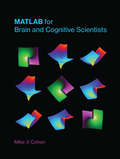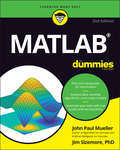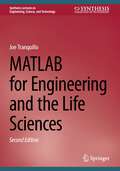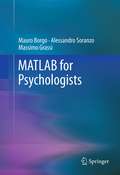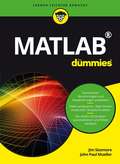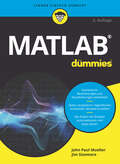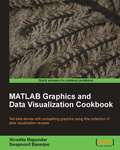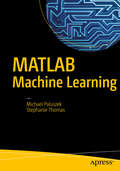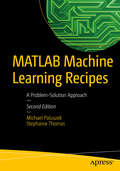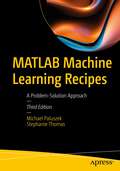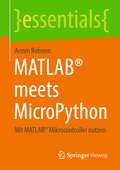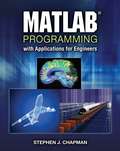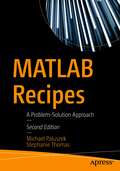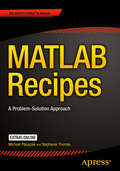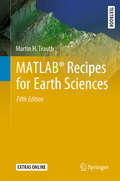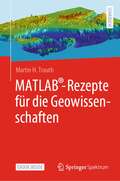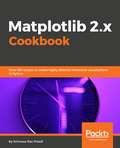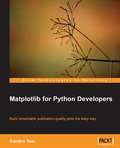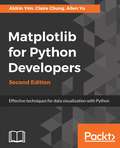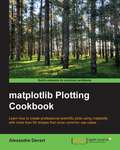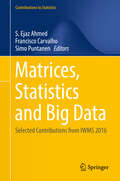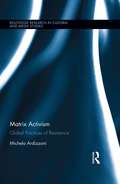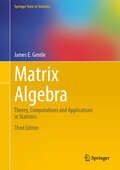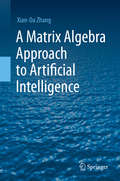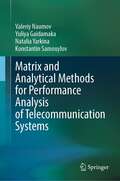- Table View
- List View
MATLAB for Brain and Cognitive Scientists
by Mike X CohenAn introduction to a popular programming language for neuroscience research, taking the reader from beginning to intermediate and advanced levels of MATLAB programming.MATLAB is one of the most popular programming languages for neuroscience and psychology research. Its balance of usability, visualization, and widespread use makes it one of the most powerful tools in a scientist's toolbox. In this book, Mike Cohen teaches brain scientists how to program in MATLAB, with a focus on applications most commonly used in neuroscience and psychology. Although most MATLAB tutorials will abandon users at the beginner's level, leaving them to sink or swim, MATLAB for Brain and Cognitive Scientists takes readers from beginning to intermediate and advanced levels of MATLAB programming, helping them gain real expertise in applications that they will use in their work.The book offers a mix of instructive text and rigorous explanations of MATLAB code along with programming tips and tricks. The goal is to teach the reader how to program data analyses in neuroscience and psychology. Readers will learn not only how to but also how not to program, with examples of bad code that they are invited to correct or improve. Chapters end with exercises that test and develop the skills taught in each chapter. Interviews with neuroscientists and cognitive scientists who have made significant contributions their field using MATLAB appear throughout the book. MATLAB for Brain and Cognitive Scientists is an essential resource for both students and instructors, in the classroom or for independent study.
MATLAB For Dummies
by John Paul Mueller Jim SizemoreGo from total MATLAB newbie to plotting graphs and solving equations in a flash! MATLAB is one of the most powerful and commonly used tools in the STEM field. But did you know it doesn’t take an advanced degree or a ton of computer experience to learn it? MATLAB For Dummies is the roadmap you’ve been looking for to simplify and explain this feature-filled tool. This handy reference walks you through every step of the way as you learn the MATLAB language and environment inside-and-out. Starting with straightforward basics before moving on to more advanced material like Live Functions and Live Scripts, this easy-to-read guide shows you how to make your way around MATLAB with screenshots and newly updated procedures. It includes: A comprehensive introduction to installing MATLAB, using its interface, and creating and saving your first file Fully updated to include the 2020 and 2021 updates to MATLAB, with all-new screenshots and up-to-date procedures Enhanced debugging procedures and use of the Symbolic Math Toolbox Brand new instruction on working with Live Scripts and Live Functions, designing classes, creating apps, and building projects Intuitive walkthroughs for MATLAB’s advanced features, including importing and exporting data and publishing your work Perfect for STEM students and new professionals ready to master one of the most powerful tools in the fields of engineering, mathematics, and computing, MATLAB For Dummies is the simplest way to go from complete newbie to power user faster than you would have thought possible.
MATLAB for Engineering and the Life Sciences (Synthesis Lectures on Engineering, Science, and Technology)
by Joe TranquilloThis book is a self-guided tour of MATLAB for engineers and life scientists. It introduces the most commonly used programming techniques through biologically inspired examples. Although the text is written for undergraduates, graduate students and academics, as well as those in industry, will find value in learning MATLAB. The book takes the emphasis off of learning syntax so that the reader can focus more on algorithmic thinking. Although it is not assumed that the reader has taken differential equations or a linear algebra class, there are short introductions to many of these concepts. Following a short history of computing, the MATLAB environment is introduced. Next, vectors and matrices are discussed, followed by matrix-vector operations. The core programming elements of MATLAB are introduced in three successive chapters on scripts, loops, and conditional logic. The last three chapters outline how to manage the input and output of data, create professional quality graphics and find and use MATLAB toolboxes. Throughout, biomedical and life science examples are used to illustrate MATLAB's capabilities.
MATLAB for Psychologists
by Alessandro Soranzo Mauro Borgo Massimo GrassiThe matrix laboratory interactive computing environment--MATLAB--has brought creativity to research in diverse disciplines, particularly in designing and programming experiments. More commonly used in mathematics and the sciences, it also lends itself to a variety of applications across the field of psychology. For the novice looking to use it in experimental psychology research, though, becoming familiar with MATLAB can be a daunting task. MATLAB for Psychologists expertly guides readers through the component steps, skills, and operations of the software, with plentiful graphics and examples to match the reader's comfort level. Using an extended illustration, this concise volume explains the program's usefulness at any point in an experiment, without the limits imposed by other types of software. And the authors demonstrate the responsiveness of MATLAB to the individual's research needs, whether the task is programming experiments, creating sensory stimuli, running simulations, or calculating statistics for data analysis. Key features of the coverage: Thinking in a matrix way.Handling and plotting data.Guidelines for improved programming, sound, and imaging.Statistical analysis and signal detection theory indexes.The Graphical User Interface.The Psychophysics Toolbox.MATLAB for Psychologists serves a wide audience of advanced undergraduate and graduate level psychology students, professors, and researchers as well as lab technicians involved in programming psychology experiments.
Matlab für Dummies (Für Dummies)
by Jim SizemoreOb Naturwissenschaftler, Mathematiker, Ingenieur oder Datenwissenschaftler - mit MATLAB haben Sie ein mächtiges Tool in der Hand, das Ihnen die Arbeit mit Ihren Daten erleichtert. Aber wie das mit manch mächtigen Dingen so ist - es ist auch ganz schön kompliziert. Aber keine Sorge! Jim Sizemore führt Sie in diesem Buch Schritt für Schritt an das Programm heran - von der Installation und den ersten Skripten bis hin zu aufwändigen Berechnungen, der Erstellung von Grafiken und effizienter Fehlerbehebung. Sie werden begeistert sein, was Sie mit MATLAB alles anstellen können.
Matlab für Dummies (Für Dummies)
by Jim Sizemore John Paul MuellerMATLAB® So lernen Sie MATLAB ideal zu nutzen Ob Naturwissenschaftler, Mathematiker, Ingenieur oder Datenwissenschaftler - mit MATLAB haben Sie ein mächtiges Tool in der Hand, das Ihnen die Arbeit mit Ihren Daten erleichtert. Aber wie das mit manch mächtigen Dingen so ist - es ist auch ganz schön kompliziert. Aber keine Sorge! Die Autoren führen Sie in diesem Buch Schritt für Schritt an das Programm heran - von der Installation und den ersten Skripten bis hin zu aufwändigen Berechnungen, der Erstellung von Grafiken und effizienter Fehlerbehebung. Sie werden begeistert sein, was Sie mit MATLAB alles anstellen können. Sie erfahren Was es mit dem MATLAB-Dateisystem auf sich hat Wie Sie mathematische Operationen mit Vektoren und Matrizen durchführen Wie Sie Funktionen und Skripte erstellen Wie Sie importieren, exportieren und publizieren.
MATLAB Graphics and Data Visualization Cookbook
by Swapnonil Banerjee Nivedita Majumdar"MATLAB Graphics and Data Visualization Cookbook" will serve as your handbook in recipe format with ample screenshots. Each independent recipe will help you in achieving target-oriented solutions to your problems with concise explanation. For those who are already using MATLAB for their computational needs but need to also harness its powerful visualization capabilities.
MATLAB Machine Learning
by Michael Paluszek Stephanie ThomasThis book is a comprehensive guide to machine learning with worked examples in MATLAB. It starts with an overview of the history of Artificial Intelligence and automatic control and how the field of machine learning grew from these. It provides descriptions of all major areas in machine learning. The book reviews commercially available packages for machine learning and shows how they fit into the field. The book then shows how MATLAB can be used to solve machine learning problems and how MATLAB graphics can enhance the programmer's understanding of the results and help users of their software grasp the results. Machine Learning can be very mathematical. The mathematics for each area is introduced in a clear and concise form so that even casual readers can understand the math. Readers from all areas of engineering will see connections to what they know and will learn new technology. The book then provides complete solutions in MATLAB for several important problems in machine learning including face identification, autonomous driving, and data classification. Full source code is provided for all of the examples and applications in the book. What you'll learn: An overview of the field of machine learning Commercial and open source packages in MATLAB How to use MATLAB for programming and building machine learning applications MATLAB graphics for machine learning Practical real world examples in MATLAB for major applications of machine learning in big data Who is this book for: The primary audiences are engineers and engineering students wanting a comprehensive and practical introduction to machine learning.
MATLAB Machine Learning Recipes: A Problem-Solution Approach
by Michael Paluszek Stephanie ThomasHarness the power of MATLAB to resolve a wide range of machine learning challenges. This book provides a series of examples of technologies critical to machine learning. Each example solves a real-world problem. All code in MATLAB Machine Learning Recipes: A Problem-Solution Approach is executable. The toolbox that the code uses provides a complete set of functions needed to implement all aspects of machine learning. Authors Michael Paluszek and Stephanie Thomas show how all of these technologies allow the reader to build sophisticated applications to solve problems with pattern recognition, autonomous driving, expert systems, and much more.What you'll learn:How to write code for machine learning, adaptive control and estimation using MATLABHow these three areas complement each otherHow these three areas are needed for robust machine learning applicationsHow to use MATLAB graphics and visualization tools for machine learningHow to code real world examples in MATLAB for major applications of machine learning in big data Who is this book for: The primary audiences are engineers, data scientists and students wanting a comprehensive and code cookbook rich in examples on machine learning using MATLAB.
MATLAB Machine Learning Recipes: A Problem-Solution Approach
by Michael Paluszek Stephanie ThomasHarness the power of MATLAB to resolve a wide range of machine learning challenges. This new and updated third edition provides examples of technologies critical to machine learning. Each example solves a real-world problem, and all code provided is executable. You can easily look up a particular problem and follow the steps in the solution.This book has something for everyone interested in machine learning. It also has material that will allow those with an interest in other technology areas to see how machine learning and MATLAB can help them solve problems in their areas of expertise. The chapter on data representation and MATLAB graphics includes new data types and additional graphics. Chapters on fuzzy logic, simple neural nets, and autonomous driving have new examples added. And there is a new chapter on spacecraft attitude determination using neural nets. Authors Michael Paluszek and Stephanie Thomas show how all of these technologies allow you to build sophisticated applications to solve problems with pattern recognition, autonomous driving, expert systems, and much more.What You Will LearnWrite code for machine learning, adaptive control, and estimation using MATLABUse MATLAB graphics and visualization tools for machine learningBecome familiar with neural netsBuild expert systemsUnderstand adaptive controlGain knowledge of Kalman FiltersWho This Book Is ForSoftware engineers, control engineers, university faculty, undergraduate and graduate students, hobbyists.
MATLAB® meets MicroPython: Mit MATLAB® Mikrocontroller nutzen (essentials)
by Armin RohnenDieses essential behandelt die Verknüpfung von MicroPython betriebenen Mikrocontroller mit MATLAB®. Anhand eines Praxisbeispiels werden die Aspekte der Planung, der elektronischen Umsetzung, der Programmierung in MicroPython, die Programmierung in MATLAB® und die Erstellung einer graphischen Oberfläche handelt.
MATLAB Programming with Applications for Engineers
by Stephen J. ChapmanThis textbook seeks to simultaneously teach MATLAB as a technical programming language while introducing the student to many of the practical functions that make solving problems in MATLAB so much easier than in other languages. It provides a complete introduction to the fundamentals of good procedural programming and aids students in developing good design habits that will serve them well in any other language that they may pick up later.
MATLAB Recipes: A Problem-Solution Approach
by Michael Paluszek Stephanie ThomasLearn from state-of-the-art examples in robotics, motors, detection filters, chemical processes, aircraft, and spacecraft. With this book you will review contemporary MATLAB coding including the latest MATLAB language features and use MATLAB as a software development environment including code organization, GUI development, and algorithm design and testing. Features now covered include the new graph and digraph classes for charts and networks; interactive documents that combine text, code, and output; a new development environment for building apps; locally defined functions in scripts; automatic expansion of dimensions; tall arrays for big data; the new string type; new functions to encode/decode JSON; handling non-English languages; the new class architecture; the Mocking framework; an engine API for Java; the cloud-based MATLAB desktop; the memoize function; and heatmap charts. MATLAB Recipes: A Problem-Solution Approach, Second Edition provides practical, hands-on code snippets and guidance for using MATLAB to build a body of code you can turn to time and again for solving technical problems in your work. Develop algorithms, test them, visualize the results, and pass the code along to others to create a functional code base for your firm. What You Will Learn Get up to date with the latest MATLAB up to and including MATLAB 2020bCode in MATLAB Write applications in MATLAB Build your own toolbox of MATLAB code to increase your efficiency and effectiveness Who This Book Is For Engineers, data scientists, and students wanting a book rich in examples using MATLAB.
MATLAB Recipes
by Stephanie Thomas Michael PaluszekLearn from state-of-the-art examples in robotics, motors, detection filters, chemical processes, aircraft, and spacecraft. MATLAB Recipes: A Problem-Solution Approach is a practical reference for industry engineers using MATLAB to solve everyday problems. With this book you will review contemporary MATLAB coding including the latest language features and use MATLAB as a software development environment including code organization, GUI development, and algorithm design and testing. This book provides practical guidance for using MATLAB to build a body of code you can turn to time and again for solving technical problems in your line of work. Develop algorithms, test them, visualize the results, and pass the code along to others to create a functional code base for your firm. What you'll learn Learn how to build industrial-strength toolboxes Move beyond a folder of scripts and create well-organized, reusable MATLAB code modules Leverage MATLAB as an IDE and not just a programming language Build a functional code base for your company or department Create your own GUIs for repeatable workflows Who this book is for This book is written for engineers and scientists who use MATLAB on a regular basis and who want to take their coding to a higher level, i. e. people who want to make commercial-quality MATLAB toolboxes. This book may be used by students who are required to use MATLAB for their courses and projects as well as professionals who use MATLAB to solve problems on the job. Table of Contents Part I: Coding in MATLAB 1. Coding Basics 2. MATLAB Style 3. Visualization 4. Interactive Graphics 5. Testing and Debugging Part II: Applications 6. The Double Integrator 7. Robotics 8. Electrical Motor 9. Fault Detection 10. Chemical Processes 11. Aircraft 12. Spacecraft
MATLAB® Recipes for Earth Sciences: Matlab® And Design Recipes For Earth Sciences (Springer Textbooks in Earth Sciences, Geography and Environment)
by Martin H. TrauthMATLAB® is used in a wide range of geoscientific applications, e.g. for image processing in remote sensing, for creating and processing digital elevation models, and for analyzing time series. This book introduces readers to MATLAB-based data analysis methods used in the geosciences, including basic statistics for univariate, bivariate and multivariate datasets, time-series analysis, signal processing, the analysis of spatial and directional data, and image analysis. The revised and updated Fifth Edition includes seven new sections, and the majority of the chapters have been rewritten and significantly expanded. New sections include error analysis, the problem of classical linear regression of log-transformed data, aligning stratigraphic sequences, the Normalized Difference Vegetation Index, Aitchison’s log-ratio transformation, graphical representation of spherical data, and statistics of spherical data. The book also includes numerous examples demonstrating how MATLAB can be used on datasets from the earth sciences. The supplementary electronic material (available online through SpringerLink) contains recipes that include all the MATLAB commands featured in the book and the sample data.
MATLAB®-Rezepte für die Geowissenschaften
by Martin H. TrauthTrauth, Martin H.MATLAB® - Rezepte für Geowissenschaften, 1. deutschsprachige Auflage, basierend auf der korrigierten 5. englischsprachigen AuflageMATLAB® wird in einer Vielzahl von geowissenschaftlichen Anwendungen eingesetzt, z.B. zur Bildverarbeitung in der Fernerkundung, zur Erzeugung und Verarbeitung digitaler Höhenmodelle und zur Analyse von Zeitreihen. Dieses Buch führt in Methoden der Datenanalyse in den Geowissenschaften mit MATLAB ein, wie z.B. grundlegende Statistik für univariate, bivariate und multivariate Datensätze, Zeitreihenanalyse, Signalverarbeitung, die Analyse räumlicher und gerichteter Daten und Bildanalyse. Der Text enthält zahlreiche Beispiele, die zeigen, wie MATLAB auf Datensätze aus den Geowissenschaften angewendet werden kann. Das ergänzende elektronische Material des Buches (online verfügbar über Springer Link) enthält Rezepte, die alle im Buch vorgestellten MATLAB-Befehle und die Beispieldaten enthalten. Das Buch soll Student:innen, Doktorand:innen, Postdoktorand:innen und Fachleuten helfen, schnelle Lösungen für gängige Datenanalyseprobleme in den Geowissenschaften zu finden.SystemanforderungenBenutzer:innen dieses Buches benötigen die MATLAB®-Software, die für Windows, macOS und Linux verfügbar ist. Die M-Files und Beispieldaten, die online über Springer Link verfügbar sind, sollten auf allen Plattformen laufen, ohne dass eine Modifikation erforderlich ist. Für diese Ausgabe haben wir MATLAB Version 9.11 (Release 2021b), die Bioinformatics Toolbox Version 4.15.2, die Image Processing Toolbox Version 11.4, die Mapping Toolbox Version 5.2, die Signal Processing Toolbox Version 8.7, Simulink 3D Animation Version 9.3, die Statistics and Machine Learning Toolbox Version 12.2 und die Wavelet Toolbox Version 6.0 verwendet.
Matplotlib 3.0 Cookbook: Over 150 recipes to create highly detailed interactive visualizations using Python
by Srinivasa Rao PoladiBuild attractive, insightful, and powerful visualizations to gain quality insights from your dataKey FeaturesMaster Matplotlib for data visualizationCustomize basic plots to make and deploy figures in cloud environmentsExplore recipes to design various data visualizations from simple bar charts to advanced 3D plotsBook DescriptionMatplotlib provides a large library of customizable plots, along with a comprehensive set of backends. Matplotlib 3.0 Cookbook is your hands-on guide to exploring the world of Matplotlib, and covers the most effective plotting packages for Python 3.7. With the help of this cookbook, you'll be able to tackle any problem you might come across while designing attractive, insightful data visualizations. With the help of over 150 recipes, you'll learn how to develop plots related to business intelligence, data science, and engineering disciplines with highly detailed visualizations. Once you've familiarized yourself with the fundamentals, you'll move on to developing professional dashboards with a wide variety of graphs and sophisticated grid layouts in 2D and 3D. You'll annotate and add rich text to the plots, enabling the creation of a business storyline. In addition to this, you'll learn how to save figures and animations in various formats for downstream deployment, followed by extending the functionality offered by various internal and third-party toolkits, such as axisartist, axes_grid, Cartopy, and Seaborn. By the end of this book, you'll be able to create high-quality customized plots and deploy them on the web and on supported GUI applications such as Tkinter, Qt 5, and wxPython by implementing real-world use cases and examples.What you will learnDevelop simple to advanced data visualizations in Matplotlib Use the pyplot API to quickly develop and deploy different plots Use object-oriented APIs for maximum flexibility with the customization of figuresDevelop interactive plots with animation and widgets Use maps for geographical plotting Enrich your visualizations using embedded texts and mathematical expressionsEmbed Matplotlib plots into other GUIs used for developing applicationsUse toolkits such as axisartist, axes_grid1, and cartopy to extend the base functionality of MatplotlibWho this book is forThe Matplotlib 3.0 Cookbook is for you if you are a data analyst, data scientist, or Python developer looking for quick recipes for a multitude of visualizations. This book is also for those who want to build variations of interactive visualizations.
Matplotlib for Python Developers
by Sandro TosiThis is a practical, hands-on book, with a lot of code and images. It presents the real code that generates every image and describes almost every single line of it, so that you know exactly what's going on. Introductory, descriptive, and theoretical parts are mixed with examples, so that reading and understanding them is easy. All of the examples build gradually with code snippets, their explanations, and plot images where necessary with the complete code and output presented at the end. This book is essentially for Python developers who have a good knowledge of Python; no knowledge of Matplotlib is required. You will be creating 2D plots using Matplotlib in no time at all.
Matplotlib for Python Developers: Effective techniques for data visualization with Python, 2nd Edition
by Allen Yu Claire Chung Aldrin YimLeverage the power of Matplotlib to visualize and understand your data more effectivelyKey FeaturesPerform effective data visualization with Matplotlib and get actionable insights from your dataDesign attractive graphs, charts, and 2D plots, and deploy them to the webGet the most out of Matplotlib in this practical guide with updated code and examplesBook DescriptionPython is a general-purpose programming language increasingly being used for data analysis and visualization. Matplotlib is a popular data visualization package in Python used to design effective plots and graphs. This is a practical, hands-on resource to help you visualize data with Python using the Matplotlib library. Matplotlib for Python Developers, Second Edition shows you how to create attractive graphs, charts, and plots using Matplotlib. You will also get a quick introduction to third-party packages, Seaborn, Pandas, Basemap, and Geopandas, and learn how to use them with Matplotlib. After that, you’ll embed and customize your plots in third-party tools such as GTK+3, Qt 5, and wxWidgets. You’ll also be able to tweak the look and feel of your visualization with the help of practical examples provided in this book. Further on, you’ll explore Matplotlib 2.1.x on the web, from a cloud-based platform using third-party packages such as Django. Finally, you will integrate interactive, real-time visualization techniques into your current workflow with the help of practical real-world examples.By the end of this book, you’ll be thoroughly comfortable with using the popular Python data visualization library Matplotlib 2.1.x and leveraging its power to build attractive, insightful, and powerful visualizations.What you will learnCreate 2D and 3D static plots such as bar charts, heat maps, and scatter plotsGet acquainted with GTK+3, Qt5, and wxWidgets to understand the UI backend of MatplotlibDevelop advanced static plots with third-party packages such as Pandas, GeoPandas, and SeabornCreate interactive plots with real-time updatesDevelop web-based, Matplotlib-powered graph visualizations with third-party packages such as DjangoWrite data visualization code that is readily expandable on the cloud platformWho this book is forThis book is essentially for anyone who wants to create intuitive data visualizations using the Matplotlib library. If you’re a data scientist or analyst and wish to create attractive visualizations using Python, you’ll find this book useful. Some knowledge of Python programming is all you need to get started.
matplotlib Plotting Cookbook
by Alexandre DevertThis book follows a cookbook style approach that puts orthogonal and non-redundant recipes in your hands. Rather than rehashing the user manual, the explanations expose the underlying logic behind Matplotlib. If you are an engineer or scientist who wants to create great visualizations with Python, rather than yet another specialized language, this is the book for you. While there are several very competent plotting packages, Matplotlib is "just" a Python module. Thus, if you know some Python already, you will feel at home from the first steps on. In case you are an application writer, you won't be left out since the integration of Matplolib is covered.
Matrices, Statistics and Big Data: Selected Contributions from IWMS 2016 (Contributions to Statistics)
by S. Ejaz Ahmed Francisco Carvalho Simo PuntanenThis volume features selected, refereed papers on various aspects of statistics, matrix theory and its applications to statistics, as well as related numerical linear algebra topics and numerical solution methods, which are relevant for problems arising in statistics and in big data. The contributions were originally presented at the 25th International Workshop on Matrices and Statistics (IWMS 2016), held in Funchal (Madeira), Portugal on June 6-9, 2016. The IWMS workshop series brings together statisticians, computer scientists, data scientists and mathematicians, helping them better understand each other’s tools, and fostering new collaborations at the interface of matrix theory and statistics.
Matrix Activism: Global Practices of Resistance (Routledge Research in Cultural and Media Studies)
by Michela ArdizzoniThe intersection of virtual and physical spaces at the heart of contemporary political protests is a pivotal element in new practices of activism. In this new and global ecology of dissent and activism, different forces, stakeholders, and spaces, once defiantly discordant, come together to define the increasingly malleable nature and terms of participatory politics and the performance of democracy. This book explores the emerging sites, aesthetics and politics of contemporary dissent as a critical attempt to foreground their mediation and negotiation in an era of neoliberal globalization. Contemporary forms of media activism occupy deeply ambivalent spaces, which Ardizzoni analyzes using the lens of what she calls "matrix activism." Rather than confining the analysis to a single platform, a single technology, or a single social actor, matrix activism allows us to explain the hybrid nature of new forms of dissent and resistance, as they are located at the intersection of alternative and mainstream, non-profit and corporate, individual and social, production and consumption, online and offline.
Matrix Algebra: Theory, Computations and Applications in Statistics (Springer Texts in Statistics)
by James E. GentleThis book presents the theory of matrix algebra for statistical applications, explores various types of matrices encountered in statistics, and covers numerical linear algebra. Matrix algebra is one of the most important areas of mathematics in data science and in statistical theory, and previous editions had essential updates and comprehensive coverage on critical topics in mathematics.This 3rd edition offers a self-contained description of relevant aspects of matrix algebra for applications in statistics. It begins with fundamental concepts of vectors and vector spaces; covers basic algebraic properties of matrices and analytic properties of vectors and matrices in multivariate calculus; and concludes with a discussion on operations on matrices, in solutions of linear systems and in eigenanalysis. It also includes discussions of the R software package, with numerous examples and exercises.Matrix Algebra considers various types of matrices encountered in statistics, such as projection matrices and positive definite matrices, and describes special properties of those matrices; as well as describing various applications of matrix theory in statistics, including linear models, multivariate analysis, and stochastic processes. It begins with a discussion of the basics of numerical computations and goes on to describe accurate and efficient algorithms for factoring matrices, how to solve linear systems of equations, and the extraction of eigenvalues and eigenvectors. It covers numerical linear algebra—one of the most important subjects in the field of statistical computing. The content includes greater emphases on R, and extensive coverage of statistical linear models. Matrix Algebra is ideal for graduate and advanced undergraduate students, or as a supplementary text for courses in linear models or multivariate statistics. It’s also ideal for use in a course in statistical computing, or as a supplementary text forvarious courses that emphasize computations.
A Matrix Algebra Approach to Artificial Intelligence
by Xian-Da ZhangMatrix algebra plays an important role in many core artificial intelligence (AI) areas, including machine learning, neural networks, support vector machines (SVMs) and evolutionary computation. This book offers a comprehensive and in-depth discussion of matrix algebra theory and methods for these four core areas of AI, while also approaching AI from a theoretical matrix algebra perspective.The book consists of two parts: the first discusses the fundamentals of matrix algebra in detail, while the second focuses on the applications of matrix algebra approaches in AI. Highlighting matrix algebra in graph-based learning and embedding, network embedding, convolutional neural networks and Pareto optimization theory, and discussing recent topics and advances, the book offers a valuable resource for scientists, engineers, and graduate students in various disciplines, including, but not limited to, computer science, mathematics and engineering.
Matrix and Analytical Methods for Performance Analysis of Telecommunication Systems
by Valeriy Naumov Yuliya Gaidamaka Natalia Yarkina Konstantin SamouylovThis introductory textbook is designed for a one-semester course on the use of the matrix and analytical methods for the performance analysis of telecommunication systems. It provides an introduction to the modelling and analysis of telecommunication systems for a broad interdisciplinary audience of students in mathematics and applied disciplines such as computer science, electronics engineering, and operations research.
